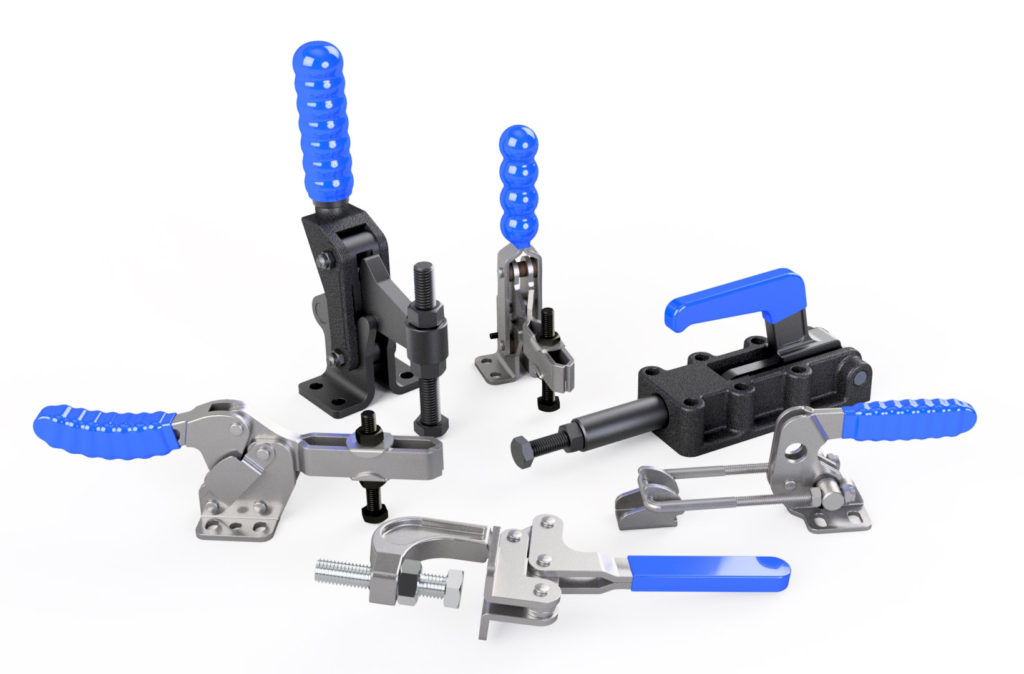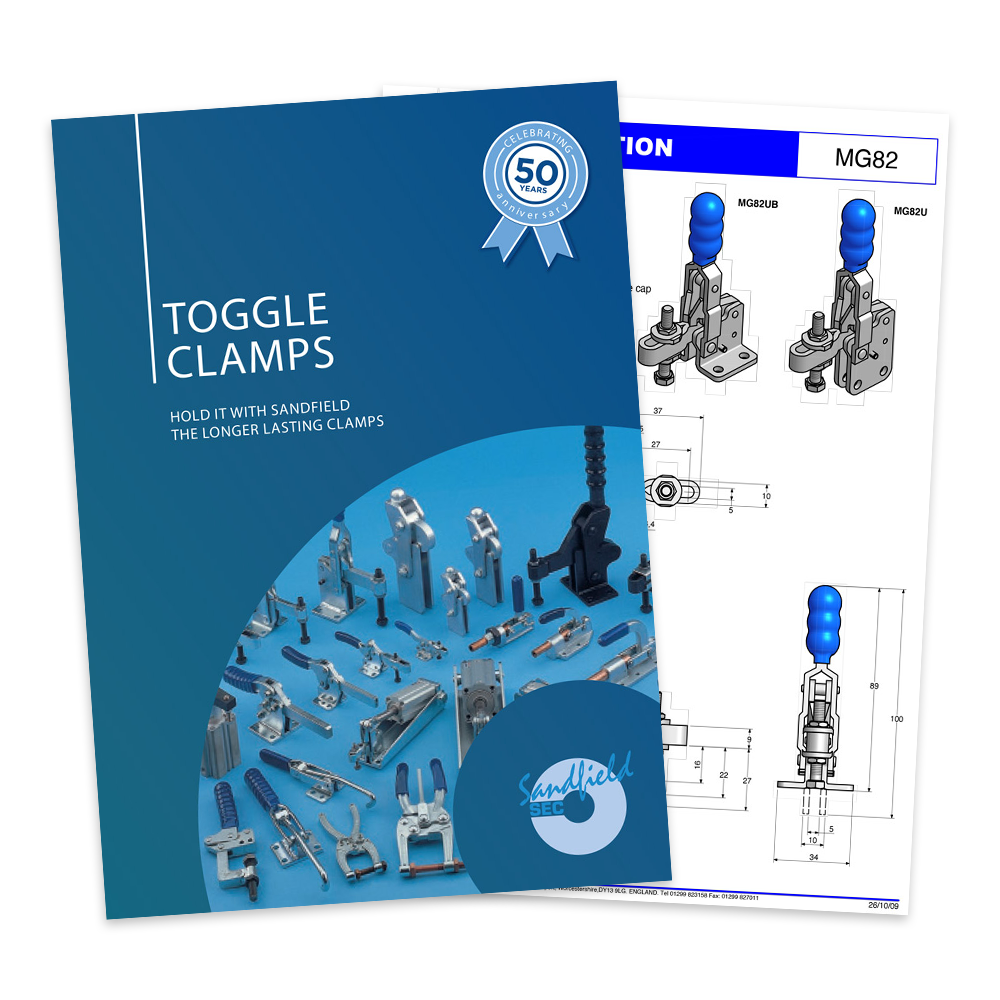Worcestershire, UK
Sandy Lane, Stourport, DY13 9QB
Send us a message
We reply within 1 day
+44(0)1299 823158
Available 9am - 5pm, Mon-Fri
Sandy Lane, Stourport, DY13 9QB
We reply within 1 day
Available 9am - 5pm, Mon-Fri
Shop hundreds of Toggle Clamp options from Sandfield Engineering – the clamp experts since 1965.
Sandfield Pneumatic Clamps are ideal for automated or repetitive holding applications.
A toggle clamp is a tool that will securely grip and hold two components or parts in position.
They provide the means to quickly secure and release a component in repetitive manufacturing processes, where workpieces need to be held tightly and then removed quickly.
Our range of toggle clamps are used in metalworking, automotive plants, food manufacture, trailers, engine testing and munitions and many other industries.

Toggle clamps are typically fixed to the work surface using a base plate mounting, either directly or using a template mounting or front mounting.
The clamp handle/lever is applied and clamp bar moves and the load is applied with a clamping bolt which is fixed to the bar.
They have a fast-action mechanism, allowing them to be engaged or released in one quick movement, the linkage system of pivot pins and levers to boost the applied force.
Once engaged, the toggle clamp is essentially locked. They are the ideal tool for when a wood or metal workpiece needs to be held in place.

Toggle Clamp, Pneumatic Clamp, Linear Rails, Toggle Press, Toggle Latch and Gripper catalogues can be found here.
“It never fails to amaze us the many innovative uses people find for our Toggle Clamps.”
The advantage of a toggle clamp is that it is quick and easy to use and the geometry of the clamp levers and pivots provide high clamping forces.
Strap clamps and G clamps or sash clamps take longer to set up and often don’t provide enough holding force needed.
As well as holding forces, toggle clamps improve efficiency, speeding up production output.
At Sandfield Engineering, we pride ourselves on the durability of our toggle clamp range. One of our first projects was for the Mini car at the Longbridge plant in the late 1950s: we provided hundreds of clamps for its assembly lines.
When the plant was decommissioned in 2000 after three million cycles, more than 70% of the original steel toggle clamps we installed on those assembly lines were still in perfect working order.
If you allow us to help specify our clamps for your purpose, we will guarantee that the clamps will perform their function, or we will either replace or refund each clamp.
If you allow us to help specify our clamps for your purpose, we will guarantee that the clamps will perform their function, or we will either replace or refund each clamp.
There are six main types of toggle clamp and they are usually defined by their action.
The most common version has a vertical clamp action. Here, a bar swings down and clamps vertically onto the components. The clamp handle/ lever when closed is in an upright position.
The clamp bar is fitted with a clamping bolt that applies the force; this may be neoprene-tipped to avoid marking the component.
A variation on vertical toggle clamps is the horizontal toggle clamp range. These clamps also provide a holding force and pressure in a downward direction, while the handle is, in its closed setting, in a horizontal position.
This horizontal variant allows a steel toggle clamp to grip when more clearance above it is needed, or where the assembly operator’s hand needs to be away from the clamp during operation.
Another common version has a straight line action, also known as push action or push pull clamps.
As these names suggest, this range applies the force in a direct pushing, straight-line direction. When the clamp is closed the handle is in the forward or vertical position depending on the model.
This type of clamp also has the advantage that, when push pull clamps are mounted vertically, with the handle in the back position, they prevent workpieces falling forwards, as the handle is behind the component in the lock position.
The fourth most common clamp variant is one that provides a hook action.
Hook or latch clamps are most often used to bring components together. Two types are available, U-bolt and single hook.
Clamps fitted with a U bolt are described as latch clamps and those with a single hook as hook clamps.
This toggle clamp has many applications, such as to hold lids on sieves or framing gates on assembly lines, or for hinged injection moulding tools.
The range of heavy duty toggle clamps can also be used for securing doors and are ideal for welding or in any workpiece where you need to hold two separate items together.
Yet another clamp option has a cam action. To operate effectively, normal toggle clamps require the workpiece thickness to be consistent.
Although there are ways to adjust for any variation when using toggle clamps, the most straightforward solution to allow for variation and still be able to rapidly apply the clamps is to use a cam action clamp.
The cam action allows for a variation in work pieces, from one to three millimeters, depending on the model.
This range of clamps offers a plier action. These steel clamps act in a squeezing motion to pull work pieces together.
They are hand-applied tools and are often used in fabrication processes, although they can also be found in the automotive industry.
Plier action toggle clamps are reasonably flexible. We can supply a range of other types with custom jaws that precisely match your components.
We know there is a huge range of clamps, presses and other products to choose from. Our interactive clamp selector tool will suggest the best options for you.
The amount of high clamping forces required and how they will be used will determine what materials are needed.
Standard or light action toggle clamps are usually made from pressed steel components with a zinc-plated finish, others are made from casting or turned parts. These may be zinc-plated or chemi-blacked.
Stainless steel should be used in regulated industries where hygiene is important, such as the food and pharmaceuticals sectors.
For use in external or harsh environments, we use 316 stainless steel, suitable because of its extreme corrosion resistance.
No problem. We know there’s a huge range of clamps, presses etc to choose from. If you answer a few quick questions about your project and clamp requirements, our interactive clamp selector tool will suggest the best options for you.
We engineer our range of toggle clamps to be as robust as they possibly can be, using hardened and ground brushes as well as bigger pins wherever we can.
To maintain your custom, horizontal or vertical clamps, particularly important if the clamps are used in an environment where there is a lot of debris, such as welding. Make a point of lubricating them regularly and cleaning them.
Our stock range means we can meet your specific secure toggle clamp requirements, from light vertical clamps to heavy duty clamps, and accessories, and deliver to almost any timescale.
If the toggle clamp you need isn’t among our wide selection, our custom design service will ensure you get exactly what you need in the material required.
Our friendly team has more than 60 years’ experience. We are happy to help, no matter how unique your current manufacturing challenge might appear.

Sandfield Engineering Company are the toggle, power and bespoke clamp experts. We design and manufacture engineering solutions that keep production lines running smoothly. We provide custom engineered solutions, prevent water pollution and drive increased efficiency through automation.
Protected by SSL Encryption
| Cookie | Duration | Description |
|---|---|---|
| cookielawinfo-checkbox-analytics | 11 months | This cookie is set by GDPR Cookie Consent plugin. The cookie is used to store the user consent for the cookies in the category "Analytics". |
| cookielawinfo-checkbox-functional | 11 months | The cookie is set by GDPR cookie consent to record the user consent for the cookies in the category "Functional". |
| cookielawinfo-checkbox-necessary | 11 months | This cookie is set by GDPR Cookie Consent plugin. The cookies is used to store the user consent for the cookies in the category "Necessary". |
| cookielawinfo-checkbox-others | 11 months | This cookie is set by GDPR Cookie Consent plugin. The cookie is used to store the user consent for the cookies in the category "Other. |
| cookielawinfo-checkbox-performance | 11 months | This cookie is set by GDPR Cookie Consent plugin. The cookie is used to store the user consent for the cookies in the category "Performance". |
| viewed_cookie_policy | 11 months | The cookie is set by the GDPR Cookie Consent plugin and is used to store whether or not user has consented to the use of cookies. It does not store any personal data. |